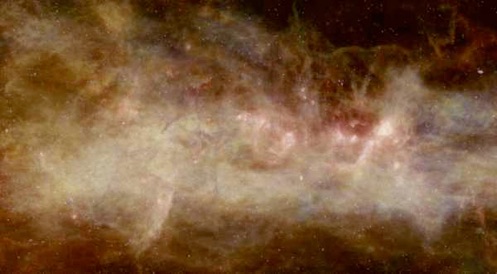
What is the Interstellar Medium?
The Interstellar Medium (aka the ISM) is literally - the stuff between the stars. Most people think that space is empty. It isn't. It's actually filled with enormous quantities of gas (atoms and molecules of various types) and dust (small solid particles just like the dust that floats around your house). The dust particles are about a micron in diameter (about 1/10th the width of a human hair) and are composed mainly of graphites (carbon) and silicates. Although the dust is in the form of particles, however, it only comprises about 1% of the mass of the ISM (the gas accounts for the other 99%).
The gas is mostly in the form of atomic hydrogen (90%) with the remainder mostly helium (and trace amounts of carbon, oxygen, nitrogen, etc.). The majority of the volume of the Galaxy (about 70%) is filled with this gas but with a very low density (less than 0.001 atoms per cubic centimeter) and a very high temperature (about 1 million degrees!). A further 25% is filled with gas that has a slightly higher density (about 0.1 atom per cubic centimeter) and is cooler (about 8000 degrees). Despite such high temperatures, if you were to stick your unprotected hand into the ISM it would freeze. This is due to the difference between temperature and heat. Temperature is a measure of the average energy of motion per gas particle. Heat is a measure of the sum of energy from the motion of all the gas particles. The gas particles in the ISM may have very high energies on average (temperature), but because the density is so low there would be few of them interacting with your hand. The remaining 5% of the volume of the ISM contains higher density (about 10 atoms per cubic centimeter) and quite cold (about 100 degrees Kelvin or -173 degrees Celcius!) material. Despite the fact that the hot part of the ISM fills most of the VOLUME of space, this cold gas comprises most of the MASS.
On smaller scales, the cold ISM can be clumped into "clouds" where the temperatures are even colder (about 20 Kelvin or -253 Celcius) and the densities are higher (greater than a few hundered gas atoms or molecules per cubic centimeter). These clouds are quite large (up to 150 light years in size) and contain mainly molecular gas, rather than atomic gas. The main consituent is molecular hydrogen (2 hydrogen atoms bound together) although there are over 100 different types of molecules known to exist in these clouds (even things like carbon monoxide, water, and alcohol!). As a result of all these molecules, these regions are called "Giant Molecular Clouds" or GMCs. These GMCs are the locations of current and future star formation, the sites of which give rise to optical nebula. Nebula are very small regions of the ISM that are near young, hot stars. The young stars heat up (to temperatures of 10,000 degrees) and ionize the nearby ISM, causing the gas to glow.
Despite the fact that the ISM contains about 15% of the visible mass of the entire Galaxy (or about 90 billion solar masses of material) the density of ISM is quite low. Assuming a typical density of 1 atom per cubic centimeter, we find that the ISM is about 10^19 (10,000,000,000,000,000,000) times less dense than the air at sea level!! That's why most people think of space as "empty" - the density is just so low. However, since the Galaxy is enormous, even these low densities ultimately add up to a huge amount of material contained in the ISM.

Image of neutral, atomic hydrogen gas towards the constellation Perseus - courtesy of the Canadian Galactic Plane Survey.

